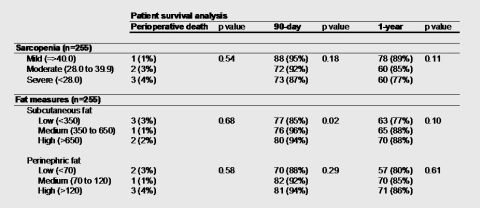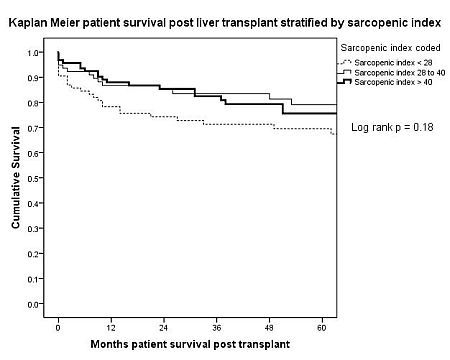Impact of Sarcopenia, Adiposity, and Malnutrition on Liver Transplant Outcomes in the Elderly
Transplant Division, Department of Surgery, Indiana University School of Medicine, Indianapolis, IN
Meeting: 2013 American Transplant Congress
Abstract number: 541
Background:
Recent research suggests that measures of frailty, such as nutrition status, may be important predictors of outcomes for liver transplantation (LT) in the geriatric population. This study seeks to assess the impact of preoperative core muscle mass, perinephric fat, and subcutaneous fat on post transplant patient survival.
Methods:
This a retrospective analysis of 356 elderly LT patients. 255 (72%) had preoperative abdominal CT scans available. Measurements of total psoas muscle area, total perinephric fat, and subcutaneous fat were taken at the L2/L3 disc space and scaled to patient height. Additionally, preoperative total serum cholesterol, protein, and albumin levels were obtained. The patient population was subdivided by tertiles into mild, moderate, and severe categories for each measure. Outcomes included patient survival and hospital stay.
Results:
Patients with severe sarcopenia had worse survival at 90-days and up to 5-years post transplant. Increased subcutaneous adipose tissue was associated with worse patient survival within the first year (90-day, p=0.02; 1-year, p=0.10) post-transplant. The group with a low amount of perinephric fat also had lower 1-year survival (90-day, p=0.29; 1-year, p=0.61). Serologic markers of nutrition were not found to be statistically associated with either early or late outcomes.


Conclusions:
In this cohort of elderly liver transplant recipients, standard serologic markers of nutrition were poor predictors of outcome. Measures of muscle and fat mass were better predictors of short and long term patient survival. These measures have been previously described as markers for patient frailty, and techniques for quantifying these values may be broadly applicable to post transplant outcomes.
To cite this abstract in AMA style:
Underwood H, Mangus R, Fridell J, Vianna R, Kubal C, Garg S, Tector A. Impact of Sarcopenia, Adiposity, and Malnutrition on Liver Transplant Outcomes in the Elderly [abstract]. Am J Transplant. 2013; 13 (suppl 5). https://atcmeetingabstracts.com/abstract/impact-of-sarcopenia-adiposity-and-malnutrition-on-liver-transplant-outcomes-in-the-elderly/. Accessed December 21, 2025.« Back to 2013 American Transplant Congress
